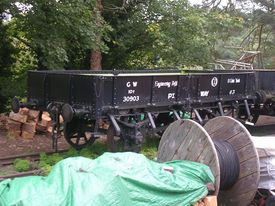Difference between revisions of "GWR 30903 Ballast Wagon"
m |
m (edit link) |
||
| Line 47: | Line 47: | ||
==Links== | ==Links== | ||
| − | [http://www.gwr813.org/pagew72.html 30903 on www.gwr813.org]<br> | + | *[http://www.gwr813.org/pagew72.html 30903 on www.gwr813.org]<br> |
| − | [http://www.ws. | + | *[http://www.ws.rhrp.org.uk/ws/WagonInfo.asp?Ref=9642 30903 on Railway Heritage Register On-Line] |
[[Category: Rolling stock owned by The GWR 813 Preservation Fund]] | [[Category: Rolling stock owned by The GWR 813 Preservation Fund]] | ||
[[Category:Featured articles]] | [[Category:Featured articles]] | ||
Revision as of 16:14, 9 April 2019
| GWRGreat Western Railway 30903 Ballast Wagon | |
|---|---|
 GWRGreat Western Railway 30903 Ballast Wagon | |
| Built By | GWRGreat Western Railway Swindon |
| Status | Operational |
| Number | 30903 |
| Other Numbers | DW 30903 |
| History | |
| Built | circa 1941 |
| Diagram | P18 |
| Lot | 1384 |
| Type | 4-wheel steel open ballast wagon |
| Capacity | 10 tons |
| Telegraphic code | BRBritish Rail or British Railways: Starfish |
| Brakes | MortonA type of brakes used on GWR wagons after Grouping in 1923, replacing the earlier DC (Dean Churchward) types. (as fitted) |
| 1973 | Arrived on SVRSevern Valley Railway |
| 1986 | Overhauled |
| 2007 | Overhauled |
The GWRGreat Western Railway did not allocate telegraphic codes to DepartmentalRolling stock used for the railway’s own functions (engineering etc.) rather than for general passenger or goods traffic. wagons of this type, although it was later classified as a STARFISH by BRBritish Rail or British Railways.
Contents
Service
30903 saw DepartmentalRolling stock used for the railway’s own functions (engineering etc.) rather than for general passenger or goods traffic. service with the GWRGreat Western Railway and BRBritish Rail or British Railways(W), ending its working life at Swindon[2].
Preservation
30903 was one of a number of such wagons purchased from Swindon in 1973 for P-Way Department use, arriving at Bewdley on 24 November 1973.[2][3] It saw regular service with that Department before receiving an overhaul in September 1986. This included the complete renewal of the platework and repairs to the drawgear. Following this overhaul, it was repainted in the GWRGreat Western Railway Engineers’ Department black livery.[4]
After a further 23 years of service with the P-Way Department, 30903 began a further overhaul in 2007. The floor and ends required replacement and by an unfortunate coincidence, these were removed on the morning of the freak storm which caused significant damage to the SVR, rendering the wagon unservicable just at a time it would be most needed. During this overhaul the thickness of the new welded floor was increased to 8mm. The repairs were completed in September 2007 with 30903 being repainted in GWRGreat Western Railway post-war engineers' livery.[5]
30903 is owned by The GWR 813 Preservation Fund.
See Also
References
- ↑ Atkins, Beard & Tourret (2013) pp. 319-320
- ↑ 2.0 2.1 SVRSevern Valley Railway Stock Book Ninth Edition
- ↑ SVRSevern Valley Railway News 30
- ↑ SVRSevern Valley Railway News 82
- ↑ SVRSevern Valley Railway News 163